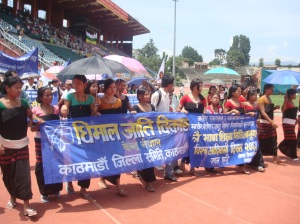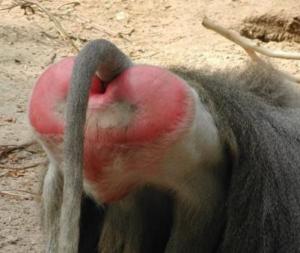Dhimal indigenism and the Subversive Resurgence of the idea of ‘Adivasi’ (Part 1)

By Janak Rai
(This is a preliminary text, so please do not cite it.)
A personal reflection and acknowledgement
I have been privileged to work with the Dhimals from Morang and Jhapa districts for my ongoing PhD research. My effort has been to understand Dhimal indigenism[1] by focusing on ‘everyday practices’ of the Dhimals. The focus on ‘everyday practice’ emerged out of the inadequacy of the pre-conceived ideas that I have regarding what constitutes the ‘proper realm’ of indigenous activism. After many months of my fieldwork and not finding the kind of ‘andolan’ that I had anticipated in Dhimals’ indigenous activism, I realized that I need to suspend my “stock of knowledge” and “conceptual lens”. What I needed was to learn the andolan (movement) from the perspectives and experiences of the Dhimals who have dedicated their whole lives in the making of the Dhimals’ indigenous movement. I thank all the Dhimal activists and ‘ordinary’ Dhimals who taught me this important lesson of doing ethnography!
The context: ‘Adivasi’ and the polarized academia in Nepal
The use of the term ‘Adivasi’ to designate to the “ethnic groups’’ of Nepal is a recent phenomenon, thanks to the resurgence of the pan-indigenous peoples’ movement and its contribution for the political transformations during the last fifteen years in Nepal. Despite the reluctance (to the extent of strong abhorrence) of many mainstream scholars (social “scientists”) towards the term, the notion of ‘adivasi’ has emerged as a powerful political category which advocates specific categories of ‘rights’ for the groups who claim or who are recognized to be ‘indigenous peoples’. This is evident when we analyze the transformation of the meaning of ‘adivasi’ in the last one decade. The wider use of the term surfaced in the early 1990s with the pan-national indigenous peoples’ movement (adivasi janajati andolan) that focused on the recognition of ‘indigenous identity’ and ‘moderate’ (from contemporary perspectives) demands like linguistic rights, declaration of Nepal as a secular state, equal representation in the governance and polity, etc. In the last five years, the meaning of ‘adivasi’ has radically transformed paralleling the political transformations in Nepal. The contemporary claims of ‘indigenous peoples’ and their organizations to restructure Nepali state based on ethnic federalism with ‘right to self-determination’ clearly demonstrates that the notion of ‘adivasi’ cannot be simply taken as a signifier of ‘identity politics’ and ‘ethnic politics’. I would argue that it has transformed or provided alternative meanings of ‘citizenry’, ‘nationhood’, ‘rights’, ‘sovereignty’ and the very idea of loktantra (peoples’ democracy). Furthermore with the ratification of ILO convention 169 and the endorsement of the UN Declaration on the Rights of Indigenous Peoples (UNDRIP) by the Nepali state in the recent years, the discourses of ‘indigenous peoples’ rights’ truly depict ‘globalization from below’. ‘Indigenous rights’ talks are no more limited in the ‘public spheres’ of the educated, “elite groups”, “experts” and indigenous activists. During this year, Dhimal friends from ‘villages’ in Morang have called me many times to bring the Nepali translations of ILO Convention 169 and UNDRIP for them. They want to use these documents to demand ‘their rights’ in the VDC, Municipality and other government offices. The idea of ‘adivasi’, though it can enact multiple meanings for individual actors, has become part of Dhimals’ collective imagination of their group identity and shared historical experiences. Arjun Appadurai (1996) suggests a new role of the ‘imagination’ in the contemporary world order. “The imagination”, he writes, ‘is now central to all forms of agency, is itself a social fact, and is key component of the new global order’ (Appadurai, 1996:31, Modernity at Large). Imagination, Appadurai clarifies, is not a mere ‘fantasy’ or ‘illusionary’ state of being. It is a lived habitus and a constituent element of any habitus in the contemporary imagined world. I do not agree with Appadurai’s representation of the contemporary imagined world as a ‘deterritorialzed world’ but this is not the focus of my present reflections (elsewhere I have argued how indigenous peoples’ movement challenges such representation. Appadurai is writing from a position of a diasporic scholar in the US, I assume). But his emphasis on ‘imagination’ is useful to approach how category like ‘adivasi’ has social life of its won (ala Social life of Things edited by Appadurai).
But academicians, particularly sociologists/anthropologists, have not quite responded to this transformation in the same manner that activists or activism oriented knowledge production has excelled on the dynamics of indigenous movements in Nepal. Why this indifference? Scholars like to lump ‘indigenous politics’ with ‘ethnic politics’ or ‘identity politics’ without seriously analyzing if these phenomena can be approached with a common framework. I should emphasize here that the conceptual tropes of ‘ethnic politics’ and ‘identity politics’ are too shallows to understand adivasi andolan and its dynamics. Conceptually, the idea of ‘ethnic group’ and ‘indigenous peoples’ are distinct. ‘Indigeneity’ is a place-based identity, a concept that focuses on how people and place produce each other. The idea of ‘self’ in the indigenous claim of right to self-determination is a ‘collective self’ that is indistinguishable (having ‘inalienable relationship’) from their territory. Secondly, ‘indigenous people’ is a globalized identity. There is no pan-Chinese American (ethnic group in the US) or Chinese-British movement on a global scale. ‘Indigenous people’ is a local identity on a global scale. 400 million and more people across the globe claim collective identity as ‘indigenous peoples’ participating in the globalized indigenous movement. Thirdly, the idea of ‘indigenous peoples’ relates to the distinct discourses about ‘rights’ which are not same as ‘ethnic rights’. So we need to approach indigenous peoples through the prism of indigenism (आदिवासीवाद); theories of ethnicity that have evolved in the contexts of Europe’s concerns with ‘immigration’ and ‘multiculturalism’ are less useful to study indigenous movement. ‘Identity politics’ is a vague concept that encompasses issues of gay rights, ethnic identity, abortion rights, etc (it does not mean these are peripheral) into a single analytical framework. We may disagree with the issues raised by adivasi andolan but misrepresenting the very essence of andolan is an entirely different academic politics. Are we ethically concerned of the political consequences that may befall upon the groups because of our misrepresentations? I advocate that we need to develop indigenism as a distinct anthropological problematic or an area of academic inquiry in Nepal.

Dhimal youths celebrating the World Indigenous Peoples’ Day (2008). Photo: Janak Rai
The other fashionable approach, an easy but short-sighted way has been to reject the very idea of ‘adivasi’ from scholarly debate. Blame the ‘foreign power’: the injection of this term by the UN, donors, INGOs, foreign scholars or even foreign trained scholars, etc. In this ‘academic slot’, ‘adivasi’ is an alien category popularized only under the aegis of the foreign ‘source-force’; a term unfit for “Nepali soil”. Nothing seems to sell in Nepal’s political culture like the idea of ‘विदेशी हस्तक्षेप’ (Foreign intervention); the Maoists are not the only clan who champions this discourse. Many academicians use this pseudo-nationalist discourse (ala Panchayat regime’s notion of देशको माटो सुहाउँदो something appropriate in accordance with the soil of the nation) to deny the ‘entry’ of the term for academic discourse and theorizing. Like any category, ‘adivasi’ is a contested notion; we do need critical analysis of the term and its associated uses. But sadly, there seems to be a clear division of labor among the academic community (believing that such a community exists): scholars belonging to the adivasi community defend the term where as non-adivasi scholars seem to disapprove the term. There are exceptions to this division of labor, but this seems to be a dominant trend in Nepal. Academia and its culture(s) in Nepal is not my area of study, and nor is this the focus of my ‘reflection’ in this blog. However it provides the background for the arguments that I develop here.
Anthropologists and others have long debated on the idea of ‘indigenous peoples’ acknowledging the urgency to shift their focus on the ways in which the idea of ‘indigeneity’ enters into peoples’ everyday imagination and practices. The use and circulation of any category, though remains influenced by the above mentioned division of labor, has social life of its own. For the groups like Dhimals the notion of ‘adivasi’ provides them a solid ‘structure of feelings’ (concept developed by Raymond William) to articulate about their cultural identity, their collective sense of self, their relationship to their places, their experiences of the Nepali state, their state of marginality, and many more things. ‘Adivasi’ is not just a travelling discourse coming from outside to be co-opted by the “manipulating” elite Dhimal activists. This is not the idea of ‘agency’ that I will like to foster in my genre of anthropology. It is not that Dhimals were devoid of other conceptual schema and they had to await the arrival of the term ‘adivasi’ to express their stories (this is not the idea of ‘local’). The social life of the notion of ‘adivasi’ cannot be conceptualized as if they operate like ‘one way traffic’; the dialogical encounter between ‘local’ and ‘global’ produces its social life in ways that can only be captured on the ground i.e. by looking into the actuality of peoples’ lives and their circumstances within which the term like ‘adivasi’ becomes a ‘structure of feelings’ that people can relate with their own stories. When Dhimals state “….हामी यो ठाउँको भूमिपुत्र हौं ” (we are the sons of this soil) they are communicating many and multiple meanings condensed in their sense of ‘bhumiputra’ (to be discussed in the later part). We need to pay closer attention, perhaps be more of ‘empathetic listeners’ than easy going critics (for example, I have often heard critiquing the use of ‘bhumiputra’ as if this is promoting what geographers call ‘geographical racism’ i.e. denying others’ belongings in a particular geography).
Even a cursory analysis of the historical trajectory of the term shows that notion of ‘adivasi’ always had multiple meanings depending upon who used it, when and for what purpose. I will cite the case of the Dhimals to illustrate this point. (to be continued later….)
[1] See Niezen (2003)
The Origins of Indigenism: Human Rights and the Politics of Identity. Los Angeles: University of California Press , for the idea of ‘indigenism’. He used the term to describe the international movement that aspires to promote and protect the rights of the world’s “First peoples”. The Dhimal activists call their ‘activism’ as an (andolan) or movement for the ‘emancipation of their jaati [ethnic group as a whole]’ -hftL d’lQmsf] cfGbf]ng_. And since their sense of being ‘adivasi’ (indigenous or aboriginal) is so strong in defining who Dhimals are, I have used ‘Dhimal indigenism’ to designate to this movements and its multitude dynamics.



